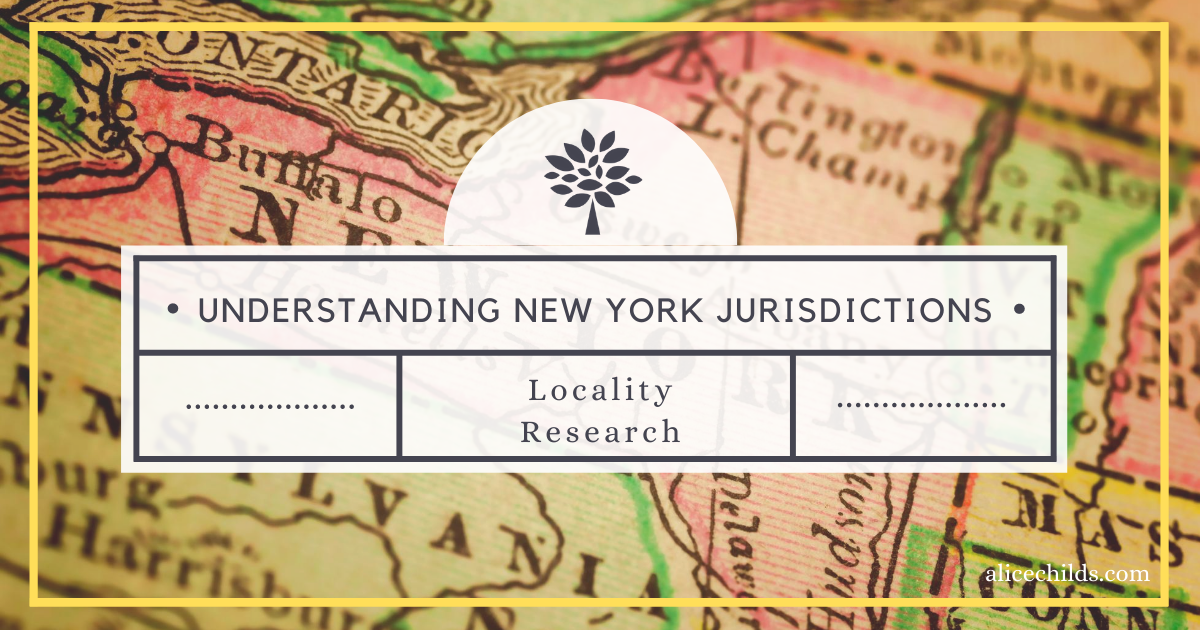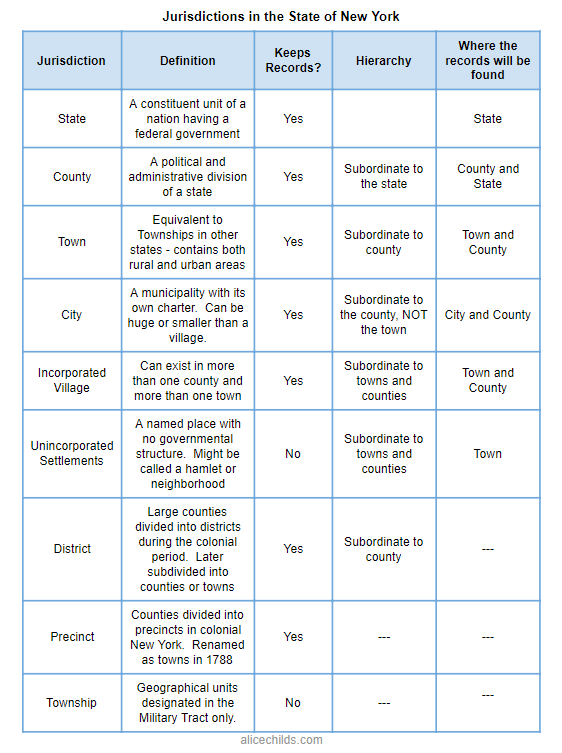
An important term to understand when engaging in genealogical research is “jurisdiction.” In general terms, jurisdiction refers to authority over a particular area or group of people. For example, the federal government has jurisdiction over the United States. Each state has jurisdiction over its geographic region. Counties and cities also have jurisdiction over geographical regions independent of the federal or state government. Jurisdiction is important to genealogists because each governing authority, or jurisdiction, creates records that can be useful to our research.
Last week I was a participant in a virtual course at the Institute of Genealogy and Historical Research (IGHR) called “Researching New York: Resources and Strategies.” It was a fantastic course and I gained a great deal of valuable knowledge about researching in New York from expert instructors Karen Mauer Jones, Jane Wilcox, Judy Russell, and Tom Jones. The first thing instructor Karen Mauer Jones wanted to ensure was that we understood jurisdictions in New York. Jurisdictions there are unique, especially the jurisdiction of town. In other states, the word town can be defined as “an urban area that has a name, defined boundaries, and local government, and that is generally larger than a village and smaller than a city.” In New York, however, towns are synonymous with townships in other regions of the United States. A New York town is a geographical region that will have many incorporated villages within its boundaries. For example, birth information for a research subject of a recent client project showed his place of birth was Warwick, Orange, New York. In Orange County, there is a village of Warwick within the Town of Warwick. Also in the Town of Warwick are a number of other hamlets and villages. Understanding this and other terminology as well as the records that are created by each jurisdiction is a key to researching in New York. After my IGHR course, I created a reference chart to help me remember the key information about jurisdictions as I research:

One other thing to remember about jurisdictions in New York is that New York City is different than the rest of the state. In 1898, the five boroughs of New York were consolidated into New York City. While each borough still functions as its own county, vital records are kept at the city level and organized by borough. The five boroughs and their counties are as follows:
- Borough of Manhattan = New York County
- Borough of the Bronx = Bronx County
- Borough of Brooklyn = Kings County
- Borough of Staten Island = Richmond County
- Borough of Queens = Queens County
When performing genealogical research in the state of New York, Karen Mauer Jones advised that it will be helpful to make a list of each jurisdiction that might have kept records for the time period of interest and check each one so that you don’t miss key records that might help break down your brick walls. One of the best resources for determining jurisdictions is the New York Family History Research Guide and Gazetteer (NYFHRGG), published by the New York Genealogical and Biographical Society. Included in the information on each county is a list of towns and cities, villages and other settlements within each town, and important notes. The gazetteer also provides a list of repositories and a list of selected print and online resources for each county. Purchase a copy directly from the NYG&B, or check with your local library to access a copy for free.

Great article! Thanks for sharing the table on New York jurisdictions – that is brilliant!
Thanks Diana! Just one of the many amazing things I learned last week.
I’m always fascinated by different states and their different jurisdictions. In Massachusetts (and other New England states), we have towns and cities (defined by their governmental structure). They are where researchers will find most records, except land and probate, which are more likely found at the county or possibly the state level, depending on the time period.
Now, New Jersey still confuses me – not only do they have cities and towns, but townships and boroughs!
I considered attending that course at IGHR – looks like I missed a good one!
It was definitely a good one. I’m so glad I took it! It sure is interesting how things vary from state to state.